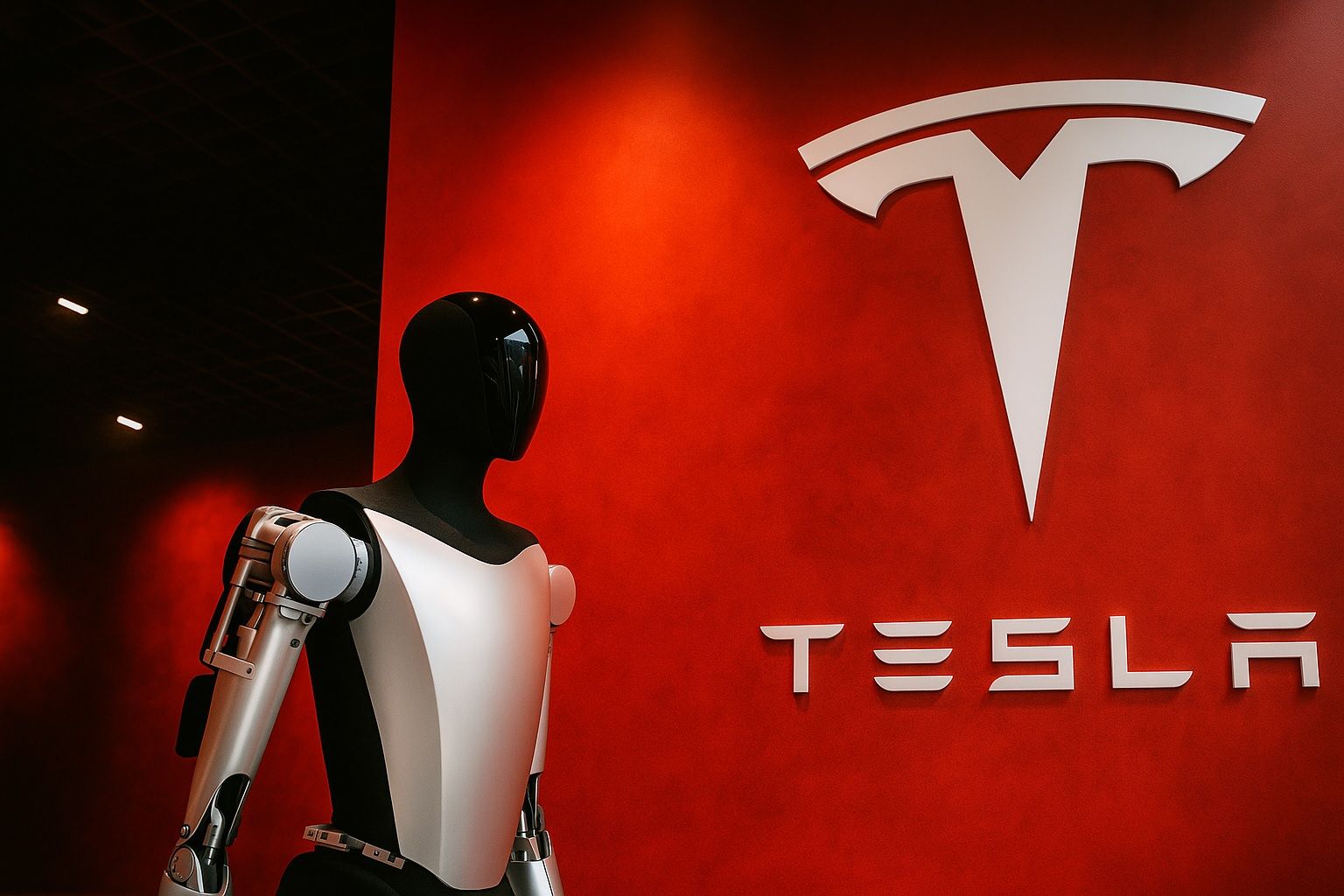Tesla (TSLA) heads into the final stretch of 2025 as one of the market’s most polarizing stocks. After a bruising year marked by slowing EV demand, intensifying competition and political controversy, the shares now trade around $390 (as of late November 2025).
At the same time, Tesla is posting record deliveries and energy storage deployments, but with shrinking margins and earnings misses. [1] And while global EV sales keep growing, Tesla’s own deliveries have slipped for the first time in over a decade, even as its valuation multiple remains far above traditional automakers. [2]
This article pulls together the latest data, analyst views and strategic developments to help you understand the Tesla stock forecast through the end of 2025. It is informational only and not financial advice.
Where Tesla stock stands heading into late 2025
- Share price: ~$391 per share in late November 2025.
- Market backdrop: high interest rates, policy uncertainty around EV incentives and intense global competition—especially from Chinese brands. [3]
Tesla’s operating performance in 2025 has been mixed:
- Record Q3 2025 deliveries: 497,099 vehicles, up 7% year over year, beating expectations of ~440,000. [4]
- Record energy storage deployments: 12.5 GWh in Q3 2025, a company record. [5]
- Profit under pressure: Q3 2025 operating profit fell ~40% year over year to $1.6 billion, with GAAP net income of $1.4 billion and non‑GAAP net income of $1.8 billion. [6]
- Earnings miss: EPS of $0.50 in Q3 2025 versus a consensus of $0.53; the stock slumped in the weeks following the report and was down about 12% from the earnings date at last check. [7]
A big part of the Q3 strength came from a rush of U.S. buyers trying to use an expiring $7,500 EV tax credit, which ended September 30. Analysts warn this likely pulled demand forward from future quarters. [8]
At the same time, Tesla’s China-made sales have been under pressure. In March 2025, Shanghai-made EV sales dropped 11.5% year over year, and total Q1 deliveries from the plant were 21.8% lower than the prior year, even as rival BYD’s sales jumped over 23%. [9]
Wall Street’s Tesla stock forecast for 2025
Average analyst price targets
Various data providers show that consensus expectations for Tesla’s share price over the next 12 months are now clustered close to where the stock trades today:
- MarketBeat: average 12‑month price target of about $394, based on 44 analysts. The range is enormous – from $19.05 on the low end to $600 on the high end. [10]
- TipRanks: average target of about $383, with a high of $600 and a low again at $19.05. The consensus rating is “Hold”, with a mix of Buy, Hold and Sell ratings. [11]
- Public.com: a 2025 price prediction around $378, very close to the current share price. [12]
- Stocksguide (2026 horizon): average analyst target of roughly $416, implying mid‑single‑digit percentage upside over a 12‑ to 18‑month period, with a high target of $630 and a low near $121. [13]
Taken together, these numbers suggest that Wall Street, on average, does not see huge upside for Tesla through the end of 2025 from today’s level—though individual analysts are wildly divided.
The wide spread between bulls and bears
The spread in price targets reflects how controversial Tesla has become:
- On the bullish side, some banks and research shops still see Tesla as a long‑term AI, autonomy and energy platform. Certain long‑term forecasts envision TSLA potentially reaching new all‑time highs by 2030 if robotaxis and software scale. [14]
- On the bearish side, J.P. Morgan cut its Tesla target to $120 in March 2025, expecting a second consecutive year of declining deliveries and citing protests, boycotts and political blowback as risks. The median target across the Street was reported around $370 at the time. [15]
The gap between a $600 bull case and a $120 bear case underlines just how uncertain any Tesla stock forecast remains for 2025.
Tesla’s fundamentals: record deliveries, shrinking profits
Deliveries and sales trends
After years of explosive growth, Tesla’s full‑year 2024 deliveries actually fell 1.1%, to about 1.79 million vehicles, marking its first annual sales decline in more than a decade. [16]
Meanwhile, the broader EV market continued to expand:
- Global EV sales rose about 22% in the first half of 2024, outpacing the overall auto market. [17]
- In 2024, Chinese EV sales grew nearly 40% year over year, and China now accounts for almost two‑thirds of global electric car sales. [18]
In other words, EV adoption is still rising, but Tesla is no longer the automatic winner in that growth.
Margin pressure from price cuts and cheaper models
To defend its share, Tesla has repeatedly cut prices and, in 2025, introduced cheaper versions of the Model Y and Model 3 priced about $5,000 lower by stripping out certain premium and basic features. [19]
Those moves have helped maintain volume but have:
- Compressed automotive gross margins,
- Reduced the contribution from high‑margin regulatory credit sales, and
- Put more pressure on earnings per share. [20]
Q3 2025 shows the trade‑off clearly: record deliveries and record energy deployments but operating profit down 40% year over year, and an EPS miss against consensus. [21]
EV market backdrop: growth continues, but Tesla’s share is under pressure
There is a lot of talk about a “global EV slowdown,” but the reality is more nuanced.
- Global EV sales jumped 23% in October 2025, reaching 1.9 million units in a single month, according to Rho Motion data. [22]
- Outside the three biggest EV markets (China, Europe, U.S.), EV sales are expected to grow more than 30% in 2025, reaching about 1.8 million units and about 6% of total car sales. [23]
However, regional and company‑specific slowdowns are very real:
- In the U.S., S&P Global expects a demand dip after key tax credits were repealed or redesigned; the EV market even contracted 6% in June 2025 versus a year earlier. [24]
- In China, Tesla’s sales have been hit by a brutal price war and a flood of local competitors. Tesla’s China‑made EV sales fell 11.5% year over year in March 2025, while BYD’s soared. [25]
BYD, Xiaomi, Nio, Xpeng, Geely and others are gaining share and aggressively expanding overseas. BYD, for example, reported $107 billion in 2024 revenue, topping Tesla’s ~$97.7 billion, and shipped over 4.3 million EVs and hybrids, though Tesla still narrowly led in pure EVs. [26]
For Tesla, this means:
- The EV pie is growing,
- But its slice is under attack, especially in China and parts of Europe,
- And defending that slice tends to cost margin.
FSD, robotaxis and energy: the optionality behind the Tesla story
Much of the long‑term Tesla bull case rests not on today’s car profits, but on future software and services revenue.
Full Self‑Driving (FSD) and robotaxis
Tesla continues to roll out new versions of Full Self‑Driving (FSD) Supervised, a driver‑assist system that can navigate city streets with human oversight. [27] In mid‑November 2025, Tesla began pushing its 2025.44 OTA update, including upgraded FSD builds that improve perception and smoother behavior but do not yet deliver full autonomy. [28]
In 2025, the company has:
- Put more emphasis on shifting from Autopilot to a more advanced FSD suite,
- Talked up ambitions for a robotaxi network, and
- Highlighted the potential of AI and autonomy to transform its business model. [29]
However, regulation is a major bottleneck:
- In Europe, regulatory delays mean FSD is unlikely to launch in full form in 2025 without significant restrictions. [30]
- Even in the U.S., widespread robotaxi deployment will require state and federal approvals, safety data, and public trust—which are still evolving.
An analysis of Tesla’s robotaxi ambitions recently estimated that hitting $75 billion in robotaxi revenue by 2030 would require overcoming both regulatory and technical hurdles, while Tesla’s core vehicle sales are under strain in 2025. [31]
Energy storage and other businesses
While autonomy gets the headlines, Tesla’s energy storage business is quietly becoming a more meaningful growth driver:
- Q3 2025 energy storage deployments of 12.5 GWh were a company record, highlighting demand for grid‑scale batteries and Powerwall products. [32]
If margins can remain healthy, this segment may help offset some volatility from the auto division.
Is Tesla overvalued in 2025?
Valuation is where opinion diverges most sharply.
- Tesla’s trailing P/E ratio is around 240x as of November 2025—orders of magnitude higher than traditional automakers and still well above many mega‑cap tech names. [33]
- Some analysts argue this premium reflects Tesla’s potential as an AI, robotics, and energy platform, not just a car company. [34]
Others see the current price as detached from fundamentals:
- One valuation‑focused analysis in August 2025 estimated that Tesla was trading at roughly a 94.5% premium to its intrinsic value based on discounted cash flows, implying a fair value near $18 per share versus a much higher market price at the time. [35]
- Another review noted Tesla’s P/E ratio had already soared close to 190x earlier in 2025 despite falling sales, questioning whether such a multiple can be sustained. [36]
At the bearish extreme, some Wall Street targets are as low as $120, while certain algorithmic models and bullish strategists see a path to $600+ over a multi‑year horizon. [37]
Bottom line on valuation: Tesla is priced for significant long‑term growth and successful execution on autonomy, software and energy. If those bets pay off, today’s price may eventually look cheap. If they don’t, the multiple leaves a lot of room for disappointment.
Scenario‑based Tesla stock forecast to the end of 2025
No one can predict where TSLA will trade in a few months, but we can outline plausible scenarios from today’s level around $390. These are illustrative only, not price guarantees or personal advice.
1. Bullish scenario: execution + sentiment recovery
Key assumptions through end‑2025:
- Q4 2025 deliveries hold up better than feared, despite the pull‑forward from the expiring U.S. tax credits. [38]
- Automotive margins stabilize as cheaper models attract new buyers and cost cuts flow through. [39]
- FSD 2025.44 and subsequent updates materially reduce interventions, leading to higher subscription adoption and more investor confidence in robotaxi plans. [40]
- Macro conditions become slightly more favorable for high‑growth stocks (e.g., rate‑cut expectations solidify).
In that case, investors might be willing to pay up again for Tesla’s AI/autonomy story, and the stock could gravitate toward the upper band of current bull targets, perhaps in the $450–$550 zone—roughly in line with the more optimistic 12‑month price targets near $600. [41]
2. Base‑case scenario: choppy but sideways overall
Assumptions:
- EV demand grows but remains uneven geographically; Tesla continues to face tough competition in China and Europe. [42]
- Q4 2025 results show modest delivery growth but continued margin pressure; energy and services/other revenue offset some auto weakness. [43]
- FSD progresses incrementally, but no major regulatory breakthrough or mass‑market robotaxi launch occurs in 2025. [44]
In this baseline, the market may continue to anchor to current consensus price targets, implying Tesla trades in a band roughly around $375–$425—not far from today’s price and in line with average Street estimates. [45]
3. Bearish scenario: demand, politics and regulation bite
Assumptions:
- Post‑tax‑credit U.S. demand disappoints, validating forecasts of an EV downturn after policy changes. [46]
- China competition intensifies further, forcing new price cuts or leaving Tesla under‑utilizing capacity. [47]
- Political and brand backlash worsens, with boycotts weighing on sales in key regions. [48]
- FSD faces additional regulatory scrutiny after incidents or fails to deliver meaningful commercial traction in 2025. [49]
Under this stress case, Tesla’s valuation multiple could compress towards more “growth auto” levels. It’s impossible to know where the market would settle, but re‑testing early‑2025 price levels around the high‑$200s or lower is not unimaginable, especially since some large banks and valuation models place fair value well under $200, with extreme outliers down to tens of dollars per share. [50]
Key catalysts for TSLA investors to watch through year‑end 2025
If you’re tracking Tesla into the end of 2025, the following catalysts may matter more than any single price target:
- Q4 2025 deliveries and margin guidance
- Will the post‑credit U.S. “demand hole” be as deep as feared?
- Do price cuts and cheaper trims stabilize volume without crushing margins? [51]
- FSD performance and regulatory progress
- Energy business growth
- Continued momentum in grid‑scale storage and residential batteries could diversify Tesla’s revenue base and smooth earnings volatility. [54]
- Competition and trade policy
- Valuation sentiment
- With a P/E near 240x, any shift in market appetite for high‑multiple growth stocks can swing TSLA sharply. [57]
Bottom line: what the 2025 Tesla stock forecast really tells you
The Tesla stock forecast through the end of 2025 is unusually split:
- Analyst averages sit roughly where the stock trades now, implying limited expected upside in the near term. [58]
- Bulls see Tesla as a once‑in‑a‑generation platform for AI, autonomy, robotics and energy.
- Bears point to slowing deliveries, fierce competition, political risk and a valuation that assumes near‑flawless execution. [59]
For investors, the key questions heading into 2026 are less about a precise year‑end price and more about:
- Do you believe Tesla can convert FSD and robotaxis into large, profitable businesses within the next decade?
- Can Tesla defend its EV share and margins in China, Europe and the U.S. amid a flood of cheaper competitors?
- Are you comfortable paying a tech‑style multiple for a company whose core business is still selling cars?
Whatever your view, Tesla remains a high‑risk, high‑reward stock. Any decision to buy, hold or sell should be based on your own risk tolerance, time horizon and independent research. This article is not investment advice.
References
1. ir.tesla.com, 2. apnews.com, 3. www.reuters.com, 4. www.wardsauto.com, 5. ir.tesla.com, 6. assets-ir.tesla.com, 7. www.nasdaq.com, 8. www.businessinsider.com, 9. www.reuters.com, 10. www.marketbeat.com, 11. www.tipranks.com, 12. public.com, 13. stocksguide.com, 14. fxopen.com, 15. www.reuters.com, 16. apnews.com, 17. autovista24.autovistagroup.com, 18. www.iea.org, 19. www.reuters.com, 20. www.reuters.com, 21. assets-ir.tesla.com, 22. carboncredits.com, 23. www.iea.org, 24. www.spglobal.com, 25. www.reuters.com, 26. nypost.com, 27. www.tesla.com, 28. www.teslaacessories.com, 29. www.teslaacessories.com, 30. www.notateslaapp.com, 31. www.ainvest.com, 32. ir.tesla.com, 33. companiesmarketcap.com, 34. www.forbes.com, 35. blog.valuesense.io, 36. malotastudio.net, 37. www.tipranks.com, 38. www.businessinsider.com, 39. www.reuters.com, 40. www.teslaacessories.com, 41. www.marketbeat.com, 42. www.reuters.com, 43. ir.tesla.com, 44. www.notateslaapp.com, 45. www.marketbeat.com, 46. www.spglobal.com, 47. www.reuters.com, 48. www.reuters.com, 49. www.notateslaapp.com, 50. markets.businessinsider.com, 51. www.businessinsider.com, 52. www.teslaacessories.com, 53. www.notateslaapp.com, 54. ir.tesla.com, 55. restofworld.org, 56. www.spglobal.com, 57. companiesmarketcap.com, 58. www.marketbeat.com, 59. apnews.com







